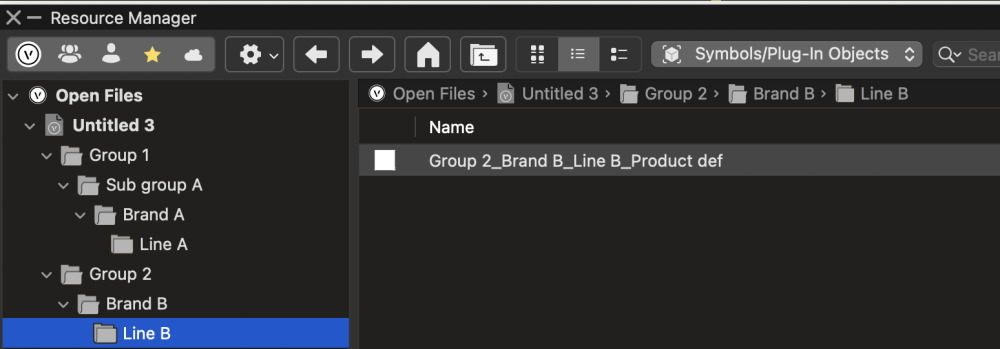
Sebastiaan
Member-
Posts
338 -
Joined
-
Last visited
Reputation
110 SpectacularPersonal Information
-
Location
Netherlands
Recent Profile Visitors
3,030 profile views
-
All Possible Things I Can Be Doing To Keep File Sizes Down
Sebastiaan replied to Chame_liam's topic in General Discussion
There is a Coffee Break seminar on the VW university about exactly this subject. It might be worth it to watch that one. some tips may be unexpected like images used in a title block can increase file size. -
script to import DWG's in place in several folders
Sebastiaan replied to Sebastiaan's topic in Vectorscript
Hi Pat, Thank you. I must admit I was secretly hoping for you. But by not having the time you motivated me to do it myself ;-). I couldn't let it go and I now have it working for the second level with nested folders too! There are a couple of items in the import that could have been in a third folder but I am not going to bother with that. Very happy with the result and that I managed myself. See the code and example file below: symid = vs.FInFolder( vs.GetObject( 'DXF_DWG' ) ) fldrlist = [] symlist = [] while vs.GetTypeN(symid)==16: symname = vs.GetName(symid) symsub = vs.SubString(symname,'_',2) if symsub not in fldrlist: fldrlist.append(symsub) symlist.append(symname) symid=vs.NextSymDef(symid) cntsym = (len(fldrlist)) cntsym2 = (len(symlist)) sym=symid scndlist = [] for i in range(len(fldrlist)): fldr1 = fldrlist[i] for j in range(len(symlist)): symname = symlist[j] scndfldr = vs.SubString(symname,'_',3) chkfldr = vs.SubString(symname,'_',2) if scndfldr not in scndlist and chkfldr == fldr1 and symname.count('_') >= 3: scndlist.append(scndfldr) vs.NameObject(fldr1) vs.BeginFolderN(16) for k in range(len(scndlist)): fldr2 = scndlist[k] vs.NameObject(fldr2) vs.BeginFolderN(16) vs.EndFolder() vs.EndFolder() scndlist.clear() for i in range(len(symlist)): symname = symlist[i] if symname.count('_') >= 3: fname = vs.SubString(symname,'_',3) else: fname = vs.SubString(symname,'_',2) insrtfldr = vs.GetObject(fname) insrtsym = vs.GetObject(symname) vs.InsertSymbolInFolder(insrtfldr, insrtsym) Folder script.vwx -
script to import DWG's in place in several folders
Sebastiaan replied to Sebastiaan's topic in Vectorscript
update: I managed to get a script working for creating folder based on a substring of the symbol names. And placing the symbols in their corresponding folders. This does not create nested folders yet, but I may leave it at this an enough of a satisfactory result. Maybe I could get it to work to create multiple nested folders if I make a list with a sublist of substrings or something like that. symid = vs.FInFolder( vs.GetObject( 'DXF_DWG' ) ) fldrlist = [] symlist = [] while vs.GetTypeN(symid)==16: symname = vs.GetName(symid) symsub = vs.SubString(symname,'_',2) #vs.AlrtDialog(symsub) fldrlist.append(symsub) symlist.append(symname) symid=vs.NextSymDef(symid) cntsym = (len(fldrlist)) vs.AlrtDialog(cntsym) sym=symid if vs.GetTypeN(sym)!=16: vs.AlrtDialog('All symbols shown') i = 1 while i < len(fldrlist): fname = fldrlist[i] chkfldr = vs.GetObject(fname) if chkfldr == 0: #vs.AlrtDialog(fname, ' ', chkfldr) vs.NameObject(fname) vs.BeginFolder() vs.EndFolder() i = i + 1 i = 0 while i < len(symlist): symname = symlist[i] fname = vs.SubString(symname,'_',2) insrtfldr = vs.GetObject(fname) insrtsym = vs.GetObject(symname) #vs.AlrtDialog(insrtsym) vs.InsertSymbolInFolder(insrtfldr, insrtsym) i = i + 1 #vs.AlrtDialog(vs.SubString(Symname,'_',2)) -
script to import DWG's in place in several folders
Sebastiaan replied to Sebastiaan's topic in Vectorscript
Maybe this topic should be moved to the Python forum because I have been trying some different code snippets in Python. I can create a folder in a folder or even two folders in one folder with the below code. It would only have to be made dynamic based on then delimited substrings of the symbols. vs.NameObject('Audio') vs.BeginFolderN(16) vs.NameObject('AudioSubfolder') vs.BeginFolderN(16) vs.EndFolder() vs.NameObject('AudioSubfolderSCND') vs.BeginFolderN(16) vs.EndFolder() vs.EndFolder() I can loop through a list of symbols in a folder and place a symbol in it's folder based on the last substring delimited by '_' However some how it only places one symbol in its folder I have to run the script again to get the next one in its folder? symid = vs.FInFolder( vs.GetObject( 'DXF_DWG' ) ) while vs.GetTypeN(symid)==16: symname=vs.GetName(symid) symdepth = symname.count('_') fname = vs.SubString(symname,'_',symdepth) insrtfldr = vs.GetObject(fname) insrtsym = vs.GetObject(symname) vs.InsertSymbolInFolder(insrtfldr, insrtsym) #vs.AlrtDialog(symdepth,fname) symid=vs.NextSymDef(symid) So making small steps, it has just been to long ago since I coded anything and these bit of code are copied from various topics. Would anyone be willing to give me a push? -
script to import DWG's in place in several folders
Sebastiaan replied to Sebastiaan's topic in Vectorscript
Ok different aproach. I used an Automator finder quick action to batch rename the DWG's with a prefix based on the nested folders that the DWG's are in. Before the name was Product abc.dwg and below is the result. This is an anonymised example file and folder structure. I can now import the DWG's as symbols into 1 file and this will at least sort the imported symbols in the recourse manager in the same order as the folder structure. With two example files this import wil look like this in the RM: Now would it be possible with a script to loop through the symbols in the RM and create folders and subfolders based on the prefixes delimited by the '_' in the symbol? The desired result would look like this: As far as I can see there won't be an issue with the 63 character limit looks like I am staying under that. The actual data set has 1000's of dwg's to convert so manual operation is not really an option. The sorted import list is already sort of workable, but if the above script would be possible I would be forever grateful. -
Hi, I have a set of many tiny DWG's spread across dozens of folders that I would want to import in place into VW files. When I use the import DWG/DXF command then I can import all DWG's into one folder or all DWG's into one file. But what I would really want is is to have a batch import where for each folder of DWG's the import is done into that folder either one VW file with all DWG's from that folder or if that's not possible for each folder containing DWG's the import is done into that folder with one VW file per DWG file. Even more I would want the DWG geometry to be imported as symbols into the VW files. Would something like this be possible or should I start thinking about apple script?
-
Spotlight Numbering Does Not Appear To Work
Sebastiaan replied to Aiden's question in Troubleshooting
Make sure that the field you want to number has a ✅ in the column ont the left of the window. also when you want to alter the setting of the field make sure that you click on the field name on the left and that it is highlited blue when you enter something in the field settings. these two are the most common user errors to check. -
Spotlight Numbering Does Not Appear To Work
Sebastiaan replied to Aiden's question in Troubleshooting
Are these older drawings? In my files there is no “Channel Number” field. Just “channel” without the number. -
Spotlight Numbering Does Not Appear To Work
Sebastiaan replied to Aiden's question in Troubleshooting
Are you using a saved set to recall your channel numbering setting? In this case there is a bug that sets the number of units per increment to zero. also make duren that when adjusting the field you want to number. That this field is highlighted blue in de spotlight numbering window. Only the field that is highlighted will be adjusted. -
Make sure the unified view is on. It is in the view menu
-
What helped for me in some cases, not al unfortunately. was to go into the edit 3d components of the truss symbol. And to move the geometry there for instance 1mm in 3D. This would force the geometry to appear again in OpenGL. Then I edited 3D again and moved the geometry back 1mm again. hopefully this helps a little bit as a temporary workaround.
-
there is a new workflow for multicell fixtures in VW 2021. You can find explanation about the new function here. https://app-help.vectorworks.net/2021/eng/index.htm#t=VW2021_Guide%2FLightingDesign1%2FConcept__Multi-cell_lighting_devices.htm&rhsearch=Multi cell&rhhlterm=Multi cell&rhsyns=
-
Hi All, I am trying to get my head around manipulating accessories through Python scripts. Ultimately I would like to be able to position an accessory by a criteria such as the accessory name. I wonder if that is even possible as the function reference only seems to give handles to accessory index and not the name, but that is for a later step. As a novice on scripting I am getting stuck on getting the GetAccPos3D & SetAccPos3D to do anything at all at this moment. First I tried GetAccCount which worked instantly: crit = "((R IN ['Lighting Device']))" def callback(h): NumAcc = vs.LDevice_GetAccCount(h, 0) vs.AlrtDialog(NumAcc) vs.ForEachObject(callback, crit) Then I tried GetAccPos3D, and the script seems to run but does not do anything. I tested the ForEachObject with a test string in an Alert dialog in the Callback, so I am sure that this does step through the lighting devices. Also I tried various combinations of the Accessory index and Cell index, but to no avail. My assumption is that a single cell lighting device would have cell index 0, and in the OIP I can see that the Accessory I am trying to manipulate has #2 as prefix before it's name in the dropdown. So I assumed that the accessory index is 2. Nonetheless I tried many other combinations as well. Also I am uncertain on how to handle the fact that this function returns multiple values. crit = "((R IN ['Lighting Device']))" def callback(h): outRotation3D, outPosition3D = vs.LDevice_GetAccPos3D(h, 0, 2) vs.AlrtDialog(outRotation3D) vs.AlrtDialog(outPosition3D) vs.ForEachObject(callback, crit) Would anyone be able to push me in the right direction?
-
Copying info from one record field to a field in another record
Sebastiaan replied to GoodPeter's topic in General Discussion
For Universe and address field since VW 2020 there is the ‘Universe/Address’ Field that Automatically combines the two fields together with a separator. You can change the separator if you like in the spotlight preferences. for other fields I recommend the AutoplotVW plugins. It has a menu command called ‘copy field to field’ that will do what you want.









